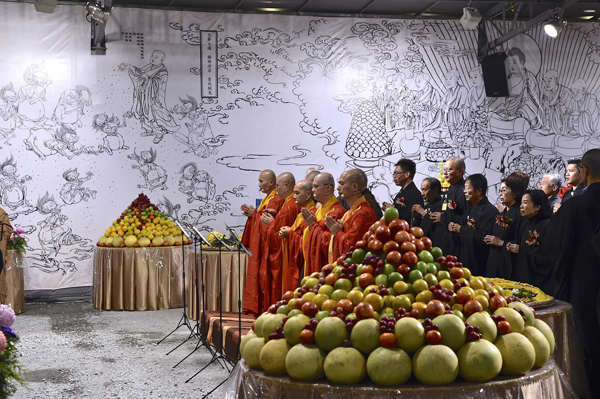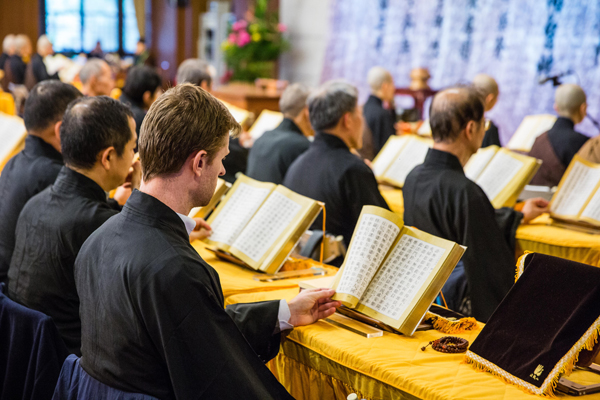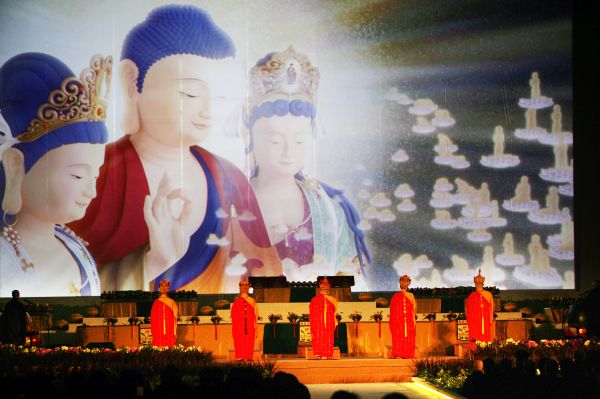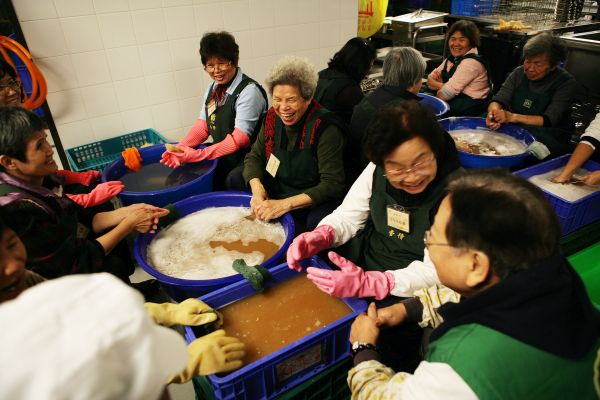Special Topics
Great Compassion Water and Land Dharma Service: Benefiting all beings of the past, present and future
Water and Land Dharma Service (shuilu fahui 水陸法會), also known traditionally as the "Water and Land Universal Deliverance and Grand Feast Assembly for Saints and Ordinary Sentient Beings in the Dharma Realm (法界聖凡水陸普度大齋勝會)" , is a practice method in Chinese Buddhism. It is considered the grandest and elaborate Dharma assembly in this tradition.
The assembly aims to liberate sentient beings in the six realms from their suffering by making offerings to all the Buddhas and saints in the ten directions, as well as organizing undiscriminating feasts for all. As these offerings are made to a wide range of recipients, this event is also highly meritorious.

A rite based on the core Buddhist spirit
A Dharma center dedicated to the practice of Chinese Buddhism, Dharma Drum Mountain organizes the Great Compassion Water and Land Dharma Service that focuses on benefitting all beings with different spiritual capacities, assisting them to be delivered and attain liberation. As human beings are part of the six realms of ordinary sentient beings, the emphasis is also placed on the self-practice of liberation from vexations.
At the campus, eleven prayer halls are set up in separate venues to offer various Dharma teachings that accommodate participants of different affinities, with the main aim to inspire them to give rise to the Bodhi mind.
Water and Land Dharma Service as a method of practice
Participating in the Water and Land Dharma Service, which is essentially a Buddhist service, means attending a group practice of learning and understanding the Dharma. With practice as its core, it's meant to invite all Buddhas and Bodhisattvas to educate participants on the practice of becoming enlightened, and also to welcome sentient beings from the ten directions to be educated on the four immeasurable states of mind on the cultivation of Buddhahood, namely loving-kindness to all beings (maitri), compassion to those in suffering (karuna), joy in the liberation of others from suffering (mudita), and equanimity (non-discrimination) to all beings, whether friends of foes (upeksha).
Therefore, participating in the Water and Land Dharma Service is similar to attending a public session on the Buddha's teachings back in the Buddha's time, where participants learn to understand and experience the teachings with a mind of compassion. This is the true spirit of participating in the Water and Land Dharma Service.
Participants of this Dharma assembly make reverent prostrations to the Buddhas, in praise and mindfulness of their merits and virtues. They also repent their bodily, mental, and verbal actions to calm their body and mind, and free themselves from afflictions, which further helps them to find the meaning and wisdom for life. This is the way of "deliverance" in its true sense.

DDM's endeavor to innovate and its unique feature
As social customs, environmental backgrounds, and the development of knowledge in modern society are very different from ancient times when the rite was compiled, the Great Compassion Water and Land Dharma Service organized by DDM in the 21st century has great significance in terms of innovation and also serves the function of re-educating monastics and lay practitioners.
To adhere to the core spirit of Mahayana Buddhism while seeking to benefit the general public in modern society, DDM presents the assembly as a cultural event that serves the purpose of public Buddhist education and social care by incorporating the elements of environmental protection, digital technology, Buddhist arts, and humanistic ideas, in terms of its form and essence.
Returning to the theoretical bases found in Buddhist sutras, upholding the ideals of environmental protection
DDM has modified the traditional procedures of the Water and Land Dharma Service by reducing elements that may not be in line with Buddhist teachings and the practices of environmental protection, to reflect both the Buddha's original intention and modern society's needs. Following guidelines to avoid any form of burning, DDM is the first Buddhist organization to adopt the use of the digital memorial tablet, which is made possible by computer animation with modern artistic design, to replace the conventional paper-made spiritual tablets for disaster mitigation and deliverance purposes. Using digital imagery as an alternative avoids waste of resources as well as air pollution, representing a break-through innovation, while better reflecting the Buddha's original intention to help the world with compassion.

Transcending religious boundaries, showing the application of diverse resources
In addition to animated virtual tablets to eliminate misfortunes and deliver the deceased, digital tablet images projected on a big screen help save space. The creative visual design transcends the form of traditional individual paper tablets, without compromising the idea that all Buddhas are kindly safeguarding all beings with compassion.
With its aim to be "pure, eco-friendly, and simple", the service combines humanistic and artistic elements, fully portraying a modern spirit. In designating and designing the venues for the event, some halls are set up in various Buddha halls on campus, while some are created by making use of spaces originally used for other purposes, such as the dining hall, balcony, auxiliary hall, and international banquet hall. The outdoor hall is established with tents set up on the sports field of Dharma Drum Institute of Liberal Arts. By making the most of interior and outdoor spaces, plus the application of modern aesthetic design and material, the Dharma assembly showcases a fresh and creative ceremonial space, successfully uplifting its quality and level and all the more conveying its idea for education and social care. It is indeed a superior group practice assembly for the benefit of the living and the deceased alike.

Of all the Eleven halls, every hall is good
The sutras recited at the 11 separate halls include most major texts for Chinese Buddhism. Each hall has its focused scripture for chanting and featured method of practice, so participants are welcome to go to the hall of their own choice to practice accordingly. During these eight days, practitioners can imagine themselves to be in a Buddha's Pure Land, and enjoy its sublime splendor and majestic dignity.
The assembly aims to liberate sentient beings in the six realms from their suffering by making offerings to all the Buddhas and saints in the ten directions, as well as organizing undiscriminating feasts for all. As these offerings are made to a wide range of recipients, this event is also highly meritorious.

A rite based on the core Buddhist spirit
A Dharma center dedicated to the practice of Chinese Buddhism, Dharma Drum Mountain organizes the Great Compassion Water and Land Dharma Service that focuses on benefitting all beings with different spiritual capacities, assisting them to be delivered and attain liberation. As human beings are part of the six realms of ordinary sentient beings, the emphasis is also placed on the self-practice of liberation from vexations.
At the campus, eleven prayer halls are set up in separate venues to offer various Dharma teachings that accommodate participants of different affinities, with the main aim to inspire them to give rise to the Bodhi mind.
Water and Land Dharma Service as a method of practice
Participating in the Water and Land Dharma Service, which is essentially a Buddhist service, means attending a group practice of learning and understanding the Dharma. With practice as its core, it's meant to invite all Buddhas and Bodhisattvas to educate participants on the practice of becoming enlightened, and also to welcome sentient beings from the ten directions to be educated on the four immeasurable states of mind on the cultivation of Buddhahood, namely loving-kindness to all beings (maitri), compassion to those in suffering (karuna), joy in the liberation of others from suffering (mudita), and equanimity (non-discrimination) to all beings, whether friends of foes (upeksha).
Therefore, participating in the Water and Land Dharma Service is similar to attending a public session on the Buddha's teachings back in the Buddha's time, where participants learn to understand and experience the teachings with a mind of compassion. This is the true spirit of participating in the Water and Land Dharma Service.
Participants of this Dharma assembly make reverent prostrations to the Buddhas, in praise and mindfulness of their merits and virtues. They also repent their bodily, mental, and verbal actions to calm their body and mind, and free themselves from afflictions, which further helps them to find the meaning and wisdom for life. This is the way of "deliverance" in its true sense.

DDM's endeavor to innovate and its unique feature
As social customs, environmental backgrounds, and the development of knowledge in modern society are very different from ancient times when the rite was compiled, the Great Compassion Water and Land Dharma Service organized by DDM in the 21st century has great significance in terms of innovation and also serves the function of re-educating monastics and lay practitioners.
To adhere to the core spirit of Mahayana Buddhism while seeking to benefit the general public in modern society, DDM presents the assembly as a cultural event that serves the purpose of public Buddhist education and social care by incorporating the elements of environmental protection, digital technology, Buddhist arts, and humanistic ideas, in terms of its form and essence.
Returning to the theoretical bases found in Buddhist sutras, upholding the ideals of environmental protection
DDM has modified the traditional procedures of the Water and Land Dharma Service by reducing elements that may not be in line with Buddhist teachings and the practices of environmental protection, to reflect both the Buddha's original intention and modern society's needs. Following guidelines to avoid any form of burning, DDM is the first Buddhist organization to adopt the use of the digital memorial tablet, which is made possible by computer animation with modern artistic design, to replace the conventional paper-made spiritual tablets for disaster mitigation and deliverance purposes. Using digital imagery as an alternative avoids waste of resources as well as air pollution, representing a break-through innovation, while better reflecting the Buddha's original intention to help the world with compassion.

Transcending religious boundaries, showing the application of diverse resources
In addition to animated virtual tablets to eliminate misfortunes and deliver the deceased, digital tablet images projected on a big screen help save space. The creative visual design transcends the form of traditional individual paper tablets, without compromising the idea that all Buddhas are kindly safeguarding all beings with compassion.
With its aim to be "pure, eco-friendly, and simple", the service combines humanistic and artistic elements, fully portraying a modern spirit. In designating and designing the venues for the event, some halls are set up in various Buddha halls on campus, while some are created by making use of spaces originally used for other purposes, such as the dining hall, balcony, auxiliary hall, and international banquet hall. The outdoor hall is established with tents set up on the sports field of Dharma Drum Institute of Liberal Arts. By making the most of interior and outdoor spaces, plus the application of modern aesthetic design and material, the Dharma assembly showcases a fresh and creative ceremonial space, successfully uplifting its quality and level and all the more conveying its idea for education and social care. It is indeed a superior group practice assembly for the benefit of the living and the deceased alike.

Of all the Eleven halls, every hall is good
The sutras recited at the 11 separate halls include most major texts for Chinese Buddhism. Each hall has its focused scripture for chanting and featured method of practice, so participants are welcome to go to the hall of their own choice to practice accordingly. During these eight days, practitioners can imagine themselves to be in a Buddha's Pure Land, and enjoy its sublime splendor and majestic dignity.
